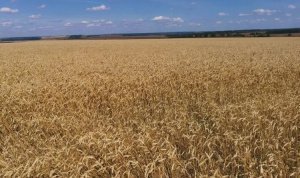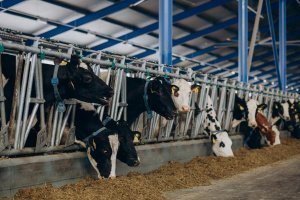Roman Bondarev, COO of LLC "Russian Land," shared insights on how to optimize agricultural enterprise workflows to factory-level precision and boost productivity.
Gleb Sosnovsky, Deputy Director of Information Technology at "Shali-Agro" in the Republic of Tatarstan, shared insights into the stages of digital transformation in their crop farming enterprise.
From Monthly Monitoring to Real-Time Management: The Need for Digitalization
In 2021, I was invited to this agricultural enterprise to lead a full-scale digital transformation. Before this, many processes were conducted on paper, and the only digital system in use was a basic vehicle monitoring system equipped with sensors installed on the machinery. This system was primarily used to close the accounting month, track fuel usage, and calculate payroll. Data was reviewed only once a month.
Such information was clearly insufficient for effective process management.
The enterprise has a large number of fields, making it very challenging to manually track all processes. At the same time, real-time information about ongoing activities is essential. Additionally, the monitoring system in place at that time had issues with the agro-module—it frequently crashed whenever a weekly report was generated.
Therefore, the management had a justified need for comprehensive, and most importantly, real-time monitoring of the current state of the enterprise. This could only be achieved through modern IT technologies.
What needed to be accomplished with the help of new technologies
The first priority was to eliminate paper documents and transition to digital formats. All processes and data needed to be accessible on computers and smartphones, rather than being buried in endless paper folders and sheets.
Next, we needed to set up a digital "assistant" capable of proactively warning about potential issues and agronomic mistakes. For instance, it needed to monitor fuel consumption and ensure compliance with the timelines for field operations—critical aspects of production. Additionally, it had to track the location of equipment and prevent situations where machinery might enter neighboring fields.
We realized that achieving this without a professional digital information system was impossible, so we began the search for a suitable solution.
We started with simple internet searches and found two similar systems. We contacted the representatives of these solutions, reviewed their features, and obtained trial access to test how they worked in real-world conditions. During testing, we preferred the interface of "AgroSignal." One of the key advantages that stood out was its user-friendly inspection template builder. In just five minutes, we could create any template tailored specifically to our needs.
Implementation and Challenges That Never Occurred
The management supported me, which eliminated 80% of the difficulties during implementation. The key was that the leadership believed in and understood the importance of the project, which inspired optimism throughout the rest of the staff down the hierarchy.
The implementation was carried out in stages. In early autumn 2021, we initiated testing, which included autumn operations such as deep tillage. During the test phase, we carefully evaluated the system's performance. After the test, we received management approval and moved on to full-scale implementation. Since the equipment at the enterprise was already equipped with sensors, we avoided the labor-intensive and costly part of the setup process.
At the beginning of the new year, we started using the digital platform to manage farm operations. However, it was necessary to train the dispatchers in the new processes. We prepared a user guide for the system and gradually transitioned tasks to the digital format. One of the first tasks added was snow removal. The dispatcher entered the information into "AgroSignal," and we in the office could see how this data was reflected on the platform.
When the season began, we trained employees to input data into all fields of the system and monitor the progress of operations. An administrator oversaw the quality of work and the accuracy of the entered data. Initially, the administrator closely monitored everything that the dispatchers input and all field activities. If any difficulties arose, they were promptly reported to management. Over time, the administrator transitioned into an analyst role.
We ensured control and peace of mind for the management.
The digital platform was designed to make business processes more transparent and provide better information to the company's management, allowing them to worry less. For instance, before implementing such a system, how did management learn about the current state of affairs at the enterprise? They would call a mechanic or manager and ask how things were going. However, this information could be inaccurate or even deliberately distorted.
The human factor had to be considered—an employee being questioned might not always be able to provide an accurate assessment. As a result, management often found themselves confused or unaware of the real situation.
Now, the data is automatically entered into the system and cannot be altered. The only exceptions are cases when sensors are not working, but this happens very rarely. Managers have access to a daily summary containing three critical indicators. If these indicators are in the "green zone," there are no issues at the enterprise, and managers can calmly focus on their leadership tasks.
This also applies to the agronomist. For example, previously, the crop history was maintained in various spreadsheets. The data for the previous year consisted solely of paper records, which were difficult to retrieve and review. Everything was in different formats, and it was unclear where to find the data. Now, everything is consolidated into a single report, which significantly simplifies the agronomist's work.
We also have a special application used by the warehouse manager. In it, they record the field, the name, and the quantity of the shipped cargo. This can include seeds, fertilizers, and plant protection products (PPP). We, in turn, check whether anything was stolen along the way and monitor if the actual quantity matches what the warehouse manager recorded.
Employees have embraced the technology, and the performance indicators have improved.
The agronomist immediately embraced the idea of digitalization and, even during the testing phase, would check daily what was happening with his fields and operations. He would call me to clarify, saying, "This field was drawn incorrectly, and this task was assigned incorrectly."
He realized that this data is stored, accessible, and useful. Now, he doesn’t need to spend time and resources on recording and remembering everything. He can focus on his professional work—agronomy.
The enterprise monitors fuel drainage, comparing planned and actual fuel consumption rates to assess the current situation. Additionally, the restriction on using neighboring fields helps save fuel. I added external land areas into AgroSignal, outlined them on the map, and set up entry restrictions. I also developed a Telegram bot that immediately alerts us if our equipment is working on foreign fields.
At the end of the season, our average fuel consumption per hectare decreased. Before digitalization, fuel theft was a common practice. Now, it’s either the most audacious mechanic or a newcomer who attempts it.
Development prospects
Now, it is impossible to operate efficiently without implementing digital technologies. If the enterprise had not invested in AgroSignal, it would have lost much more. Thanks to this system, efficiency has significantly increased. Additionally, the platform has become a reliable assistant, monitoring everything that is happening.
On our path to digital transformation, AgroSignal has been a great help. Now, we can monitor all field operations on the computer. We’ve begun the digitalization of the farm, and we understand that this is far from the end: we aim to create a complete digital replica of our enterprise, where not only fieldwork but also critically important farm processes will be duplicated in digital format. I believe this is not only achievable but also essential.



